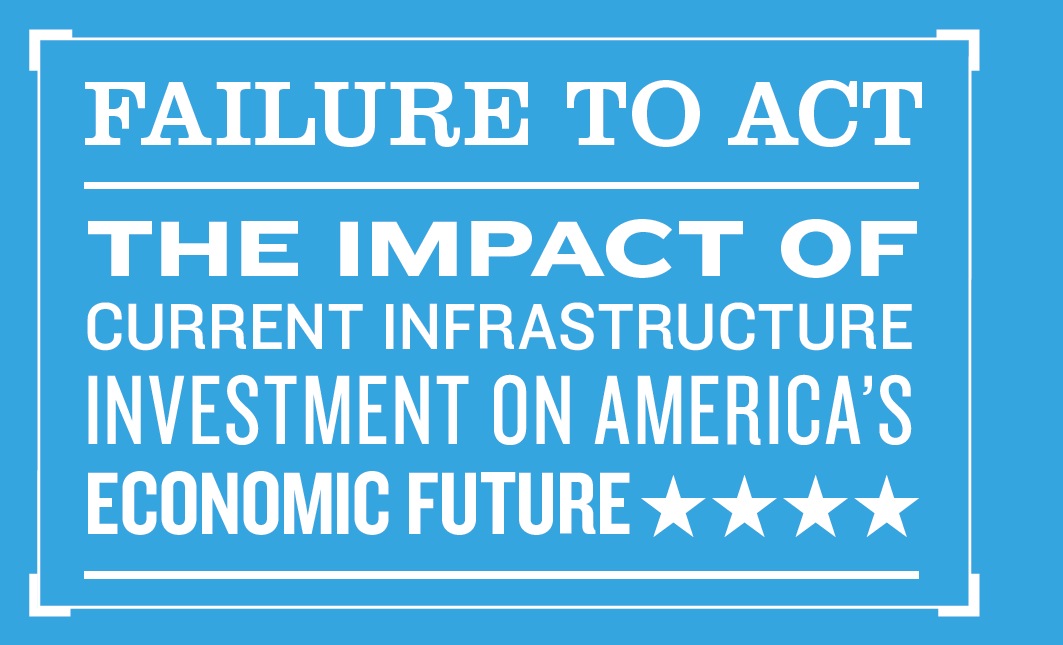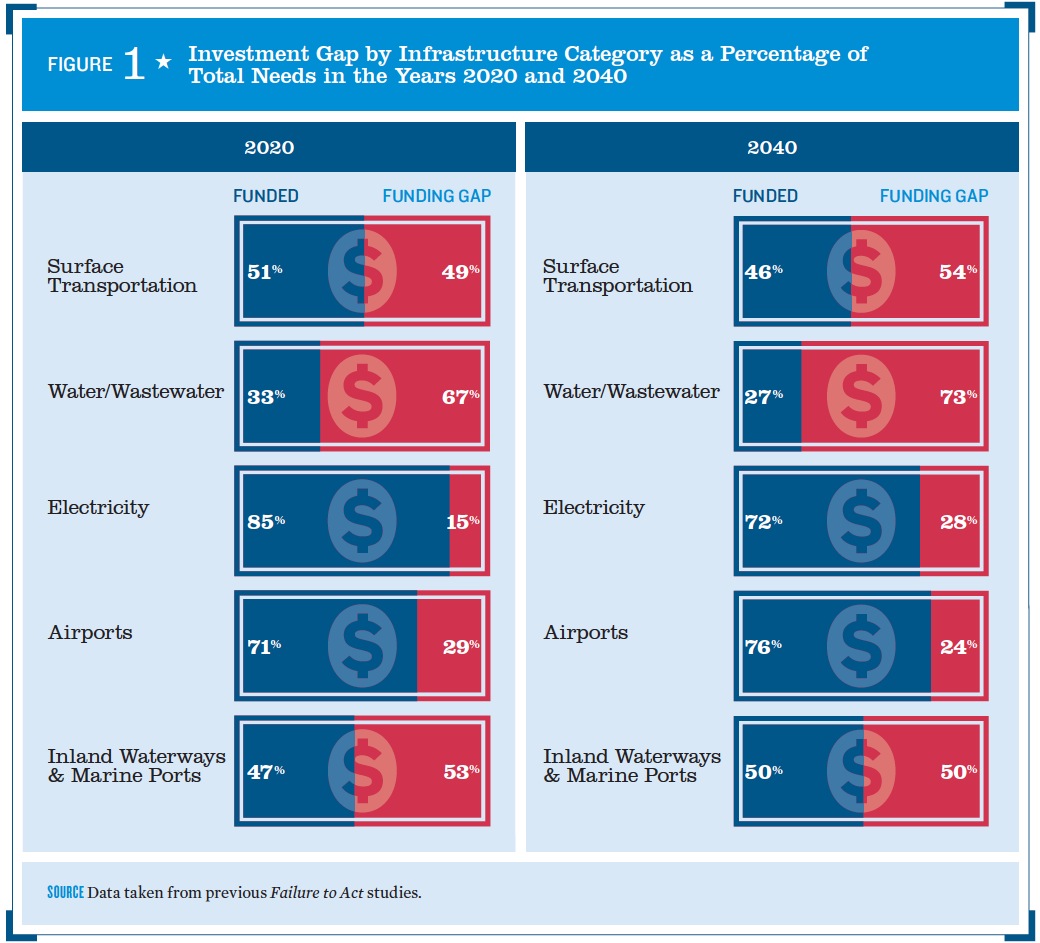AMERICAN SOCIETY OF CIVIL ENGINEERS (ASCE)
Introduction
 Infrastructure is the physical framework upon which the U.S. economy operates and the nation’s standard of living depends. Everything depends on this framework, including transporting goods, powering factories, heating and cooling office buildings, and enjoying a glass of clean water.
Infrastructure is the physical framework upon which the U.S. economy operates and the nation’s standard of living depends. Everything depends on this framework, including transporting goods, powering factories, heating and cooling office buildings, and enjoying a glass of clean water.
The preceding four Failure to Act reports compared current and projected needs for infrastructure investment against the current funding trends in surface transportation; water and wastewater; electricity; and airports, inland waterways, and marine ports. Our projections included both the cost of building new infrastructure to service increasing populations and the cost of expanded economic activity; and for maintaining or rebuilding existing infrastructure that needs repair or replacement. The total documented cumulative gap between projected needs and likely investment in these critical systems will be $1.1 trillion by 2020. The subsequent analyses focused on the long-term effects associated with infrastructure investments and did not consider the immediate benefits associated with the construction process. The results show that deteriorating infrastructure, long known to be a public safety issue, has a cascading impact on the nation’s economy, negatively affecting business productivity, gross domestic product (GDP), employment, personal income, and international competitiveness.
The categories of infrastructure systems analyzed in the preceding Failure to Act reports were reviewed in isolation by each study. However, it is clear that there is an interactive effect between different infrastructure sectors and a cumulative impact of an ongoing investment gap in multiple infrastructure systems. For example, regardless of how quickly goods can be offloaded at the nation’s ports, if highway and rail infrastructure needed to transport these goods to market is congested, traffic will slow and costs to business will rise, creating a drag on the U.S. economy that is ultimately reflected in a lower GDP.
This fifth and final report analyzes the interactive effect between investment gaps in the infrastructure sectors addressed in each of the preceding studies. It presents an overall picture of the national economic opportunity associated with infrastructure investment and the consequences of failing to fill the investment gap.
The overall impact of deficient infrastructure associated with a general failure to invest cannot be estimated by simply adding the impacts found in each report because the degradation of surface transportation, water delivery and wastewater treatment, electricity, inland waterways, and marine ports each affect business productivity differently. Shifts to other production methods or modes of infrastructure may be possible given a decline in one system, which could mitigate the economic impacts of failing to invest in that system. For example, rail, inland waterways, and trucks are used to get goods to retail shelves —deteriorating conditions in one sector tend to make the other sectors more competitive. However, a general decline in infrastructure conditions across multiple sectors would preclude such strategies.
In addition, the consequences of infrastructure shortfalls differ by each system. With degrading surface transportation, trips can still be made, but they would take longer and be less reliable, and travel could be less safe. Declining airport and marine port infrastructure directly impacts the nation’s ability to import and export goods efficiently, driving up costs to U.S. consumers.
Overall, if the investment gap is not addressed throughout the nation’s infrastructure sectors, by 2020, the economy is expected to lose almost $1 trillion in business sales, resulting in a loss of 3.5 million jobs. Moreover, if current trends are not reversed, the cumulative cost to the U.S. economy from 2012–2020 will be more than $3.1 trillion in GDP and $1.1 trillion in total trade.
Often, estimates of economic activity and job creation focus on the design and construction period for infrastructure projects, such as a project to rebuild an aging bridge. However, this study focuses on the incremental and gradual decline of infrastructure systems under current investment scenarios, and it shows that the negative impacts on the nation’s economy are exacerbated over time as needed investments are deferred. Conversely, this study demonstrates that the economic benefits of infrastructure investment reverberate through every sector of the economy over time.
 Download full report (PDF): Failure to Act: The Impact of Current Infrastructure Investment on America’s Economic Future
Download full report (PDF): Failure to Act: The Impact of Current Infrastructure Investment on America’s Economic Future
About the American Society of Civil Engineers (ASCE)
www.asce.org
“Founded in 1852, the American Society of Civil Engineers (ASCE) represents more than 147,000 members of the civil engineering profession worldwide, and is America’s oldest national engineering society. ASCE’s vision is to position engineers as global leaders building a better quality of life…Comprised of Regional Councils, Younger Member Councils, Sections, Branches, Student Chapters and Clubs and International Student Groups, the Society and its volunteers are fully engaged in making this a better world by design.”
Tags: airports, American Society of Civil Engineers, ASCE, Electricity, Failure to Act, Infrastructure Investment, Marine Ports, Surface Transportation






 RSS Feed
RSS Feed